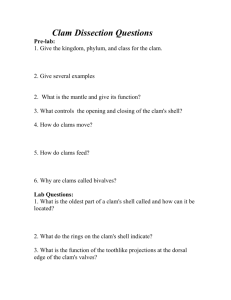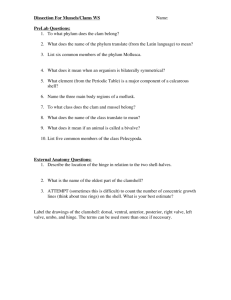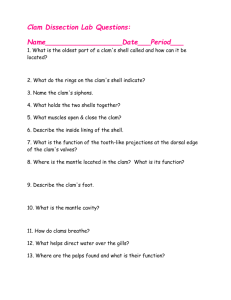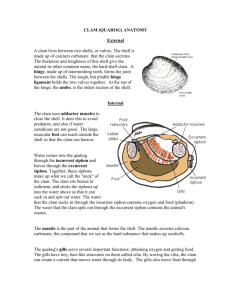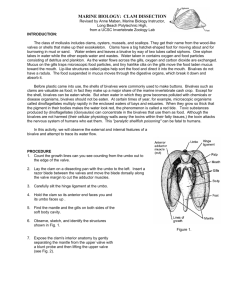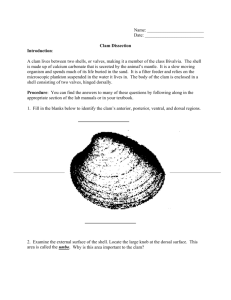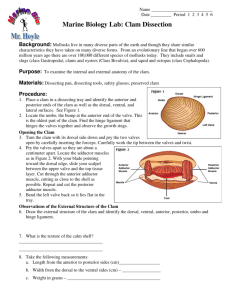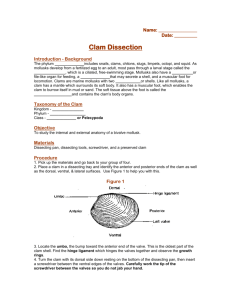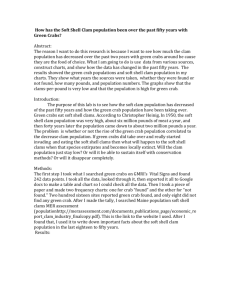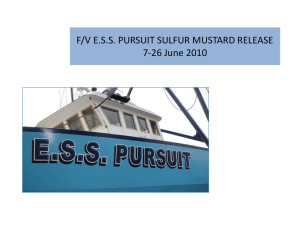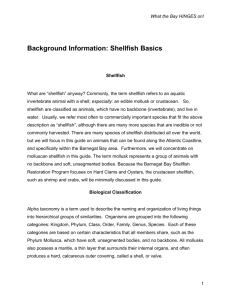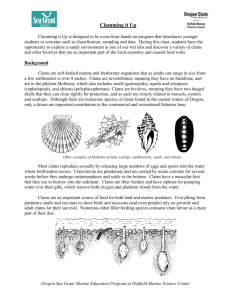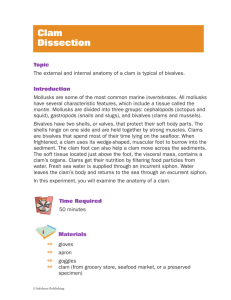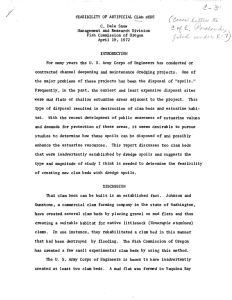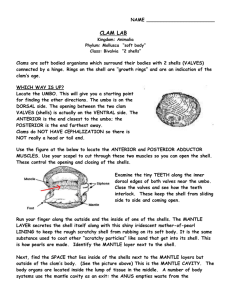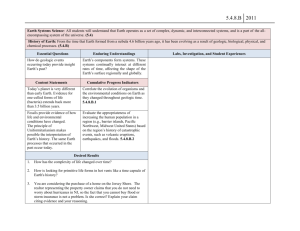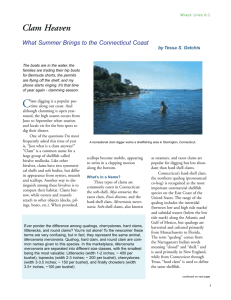Common Clam Varieties
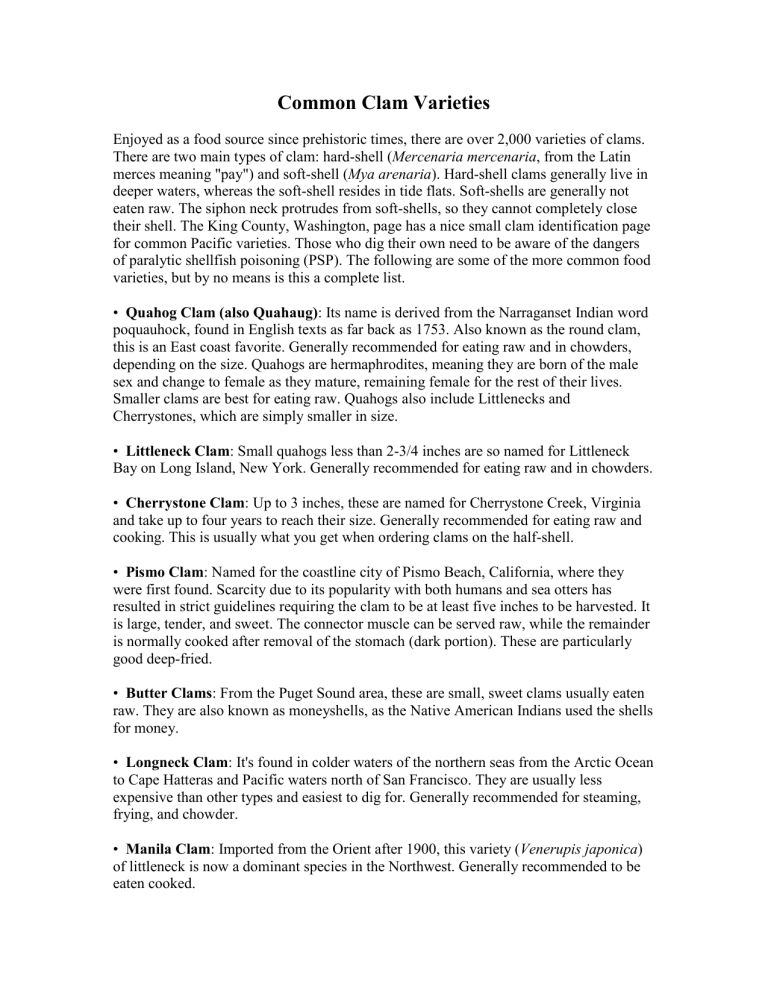
Common Clam Varieties
Enjoyed as a food source since prehistoric times, there are over 2,000 varieties of clams.
There are two main types of clam: hard-shell ( Mercenaria mercenaria , from the Latin merces meaning "pay") and soft-shell ( Mya arenaria ). Hard-shell clams generally live in deeper waters, whereas the soft-shell resides in tide flats. Soft-shells are generally not eaten raw. The siphon neck protrudes from soft-shells, so they cannot completely close their shell. The King County, Washington, page has a nice small clam identification page for common Pacific varieties. Those who dig their own need to be aware of the dangers of paralytic shellfish poisoning (PSP). The following are some of the more common food varieties, but by no means is this a complete list.
•
Quahog Clam (also Quahaug) : Its name is derived from the Narraganset Indian word poquauhock, found in English texts as far back as 1753. Also known as the round clam, this is an East coast favorite. Generally recommended for eating raw and in chowders, depending on the size. Quahogs are hermaphrodites, meaning they are born of the male sex and change to female as they mature, remaining female for the rest of their lives.
Smaller clams are best for eating raw. Quahogs also include Littlenecks and
Cherrystones, which are simply smaller in size.
•
Littleneck Clam : Small quahogs less than 2-3/4 inches are so named for Littleneck
Bay on Long Island, New York. Generally recommended for eating raw and in chowders.
•
Cherrystone Clam : Up to 3 inches, these are named for Cherrystone Creek, Virginia and take up to four years to reach their size. Generally recommended for eating raw and cooking. This is usually what you get when ordering clams on the half-shell.
•
Pismo Clam : Named for the coastline city of Pismo Beach, California, where they were first found. Scarcity due to its popularity with both humans and sea otters has resulted in strict guidelines requiring the clam to be at least five inches to be harvested. It is large, tender, and sweet. The connector muscle can be served raw, while the remainder is normally cooked after removal of the stomach (dark portion). These are particularly good deep-fried.
•
Butter Clams : From the Puget Sound area, these are small, sweet clams usually eaten raw. They are also known as moneyshells, as the Native American Indians used the shells for money.
• Longneck Clam : It's found in colder waters of the northern seas from the Arctic Ocean to Cape Hatteras and Pacific waters north of San Francisco. They are usually less expensive than other types and easiest to dig for. Generally recommended for steaming, frying, and chowder.
•
Manila Clam : Imported from the Orient after 1900, this variety ( Venerupis japonica ) of littleneck is now a dominant species in the Northwest. Generally recommended to be eaten cooked.
•
Razor Clam : Named for its sharp shell and its resemblance to a straight-edge razor, the
East coast variety of this clam ( Ensis directus ) is not as easy to catch as its West coast counterpart, and thus not as popular. However, the unrelated Pacific razor clam ( Siliqua patula ) is quite popular on the West Coast and is considered to have superior flavor.
Recommended for frying and soups.
•
Geoduck Clam : Related to the giant clam, this odd-looking variety ( Panopea generosa ) grows up to eight inches in length and can weigh in at over five pounds, although most are harvested at under three pounds. Some varieties in the deep sea can grow to over one hundred pounds. The word geoduck (pronounced "gooey-duck") first appeared in print in 1883 and comes from the Nisqualli Indian word for "dig deep." (You may also see it spelled gweduck.) Digging deep is indeed how they are harvested commercially, from trenches sometimes up to seventy feet deep. The neck of the geoduck, which can be several feet long, can often be spotted sticking out of the sand during very low tides, since it cannot be withdrawn into its shell. Even at low tide, the body of the clam may be as much as four feet below the sand, requiring a tenacious digger.
The neck of the geoduck is usually parboiled and skinned, with skins reserved and ground for chowder. The stomach (dark portion) of the body is removed and the rest carved into 1/4-inch steaks, which are considered by many to be superior to abalone. Due to their size, they have a tough texture and are generally not eaten raw.
Most of the US geoduck harvest ends up in Japan, where they are called mirugai.
They are prized for the neck and the rest of the body is usually discarded. http://nighthawk.tricity.wsu.edu/museum/ArcherdShellCollection/ShellCollection.html
Washington State University Shell collection


